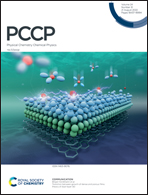Ab initio non-covalent crystal field theory for lanthanide complexes: a multiconfigurational non-orthogonal group function approach†
Abstract
We present a multiconfigurational ab initio methodology based on non-orthogonal fragments for the calculation of crystal field energy levels and magnetic properties of lanthanide complexes, implementing a systematic description of non-covalent contributions to metal–ligand bonding. The approach consists of two steps. In the first step, appropriate ab initio wave functions for the various ionic fragments (lanthanide ions and coordinating ligands) are optimized separately, accounting for the influence of the surrounding environment within various approximations. In the second and final step, the scalar relativistic (DKH2) electrostatic Hamiltonian of the whole molecule is represented on the basis of the optimized metal–ligand multiconfigurational non-orthogonal group functions (MC-NOGFs), and reduced to an effective (2J + 1)-dimensional non-orthogonal configuration interaction (CI) problem via Löwdin-partitioning. Within the proposed formalism, the projected non-orthogonal CI Hamiltonian can be expanded to any desired order of perturbation theory in the fragment-localised excitations out of the degenerate space, and its eigenvalues and eigenfunctions provide systematic approximations to the crystal field energies and wave functions. We present here a preliminary implementation of the proposed MC-NOGF method developed for first-order degenerate perturbation theory within our own ab initio code CERES, and compare its performance both with the simpler non-covalent orthogonal ab initio approach, Fragment Ab Initio Model Potential (FAIMP) approximation, and the full CAHF/CASCI-SO method, accounting for metal–ligand covalency in a mean-field manner. We found that the energies and magnetic properties of 44 complexes obtained via an iteratively optimized version of our MC-NOGF first-order non-covalent method compare remarkably well with those obtained using the full CAHF/CASCI-SO method including metal–ligand covalency, thus exposing the predominantly electrostatic character of the metal–ligand interactions, and are superior to those obtained using the FAIMP approach, which in its iteratively optimised variant was believed to date to be the best ab initio description of non-covalent metal–ligand interactions.



 Please wait while we load your content...
Please wait while we load your content...